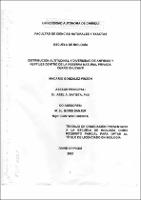Distribución altitudinal y diversidad de anfibios y réptiles dentro de la reserva natural privada cerro Chucantí.
Abstract
The herpetofauna of the private natural reserve Cerro Chucantí, in Darién, Panama, was studied in order to determine its diversity, species richness and attitude distribution. The field work was carried out during the months of January 2018 to March 2019, within the private natural reserve Cerro Chucantí. where a total of 17 transects of 200 m were located along the path that crosses the mountain, locating them in three altitudinal levels between 700 m and 1,439 m of altitude, and they were sampled during 3 months of the dry season and 3 months of the rainy season, making two replications in total for all transects in each station. The samplings were carried out in two periods, daytime, from 07:00 to 12:00 and night, from 19:00 to 00:00, dedicating a total average of 10 hours/ man per day per transect. A total of 63 days and 630 man-hours of work were put in during the project. Information on the temperature of the place was also collected throug the thermal sensors, which were left at different elevations in Cerro Chucantí, from May to August 2018 and from October to February 2019. A total of 5,441 Individuals were registered, 5,209 were of the Class Amphibia grouped into 3 orders, 13 families and 36 species, and of the Reptilia Class, a total of 232 individuals belonging to a single order, 8 families and 36 species were recorded The largest family of amphibians was Craugastoridae, with individuals present in allfloors, followed by Dendrobatidae. For the reptiles, the most abundant families were Gymnophtalmidae and Phyllodactylidae, dso present in the three floors evaluated. Some changes were observed in the abundance patterns for amphibians as a function of the changes in the two evaluated seasons (dry and rainy). Some of the amphibian species found are currently under threat categories according to organisms such as the IUCN and national legislation, which makes it important to carry out more detailed studies on the population status of these species for their better conservation.

